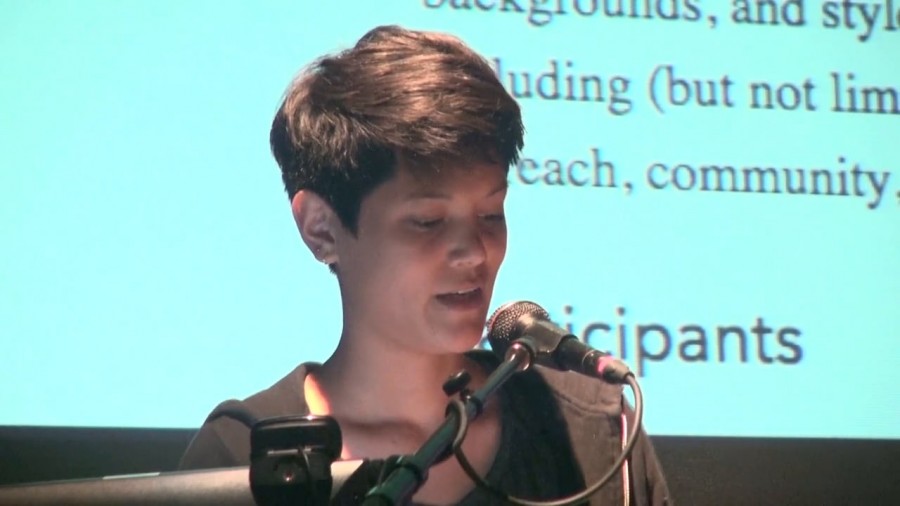Golan Levin: Thank you all so much for coming out this evening, and welcome to “Diversity: Seven Voices on Race, Gender, Ability & Class for FLOSS and the Internet.” My name is Golan Levin, I’m the director of the Frank-Ratchye Studio for Creative Inquiry here at Carnegie Mellon University, and welcome on this Tuesday, May 26 2015 to this little symposium that we are co-hosting with the p5.js organization.
p5.js of course is one of the major toolkits for open-source arts engineering. Major in spite of the very small number of people who are actually working on it. As part of the Studio’s desire to support the tools and techniques that make new forms of art, particularly new media arts, possible, we applied for a grant from the National Endowment for the Arts to support the arts engineering toolkits. We received a small grant and with it we decided to invite the p5.js organization to have its first contributors’ conference here this year. So the p5.js folks, there’s about twenty-five or thirty of them, are gathering in the Studio for Creative Inquiry this week to push forth on the latest version of p5.js software, which will have great repercussions enabling thousands, perhaps even tens of thousands, of other artists around the world, and designers to create new kinds of work.
I just want to thank our sponsors before I introduce Lauren, who’s the founder of the p5.js organization. As I mentioned, I’m Golan Levin from the Frank-Ratchye Studio for Creative Inquiry, and some funds from the Frank-Ratchye Fund for Art at the Frontier have helps support tonight’s event. The bulk of our funding is from the National Endowment for the Arts’ Art Works and Artist Communities Programs. This event was also made possible by generous support from the NYU Interactive Telecommunications Program, the Processing Foundation, a company called The Artificial in the Netherlands, Bocoup, Darius Kazemi, and the Emergent Digital Practices Department at the University of Denver in Colorado.
With that, I’d like to introduce Lauren McCarthy, who is the founder of the p5.js organization, and its spiritus rector, as she talks a bit about where we’re going. Thank you.
Lauren McCarthy: When we started conceiving of this idea, Golan challenged me to think about how this panel would related specifically to p5.js, and for me it was kind of a no-brainer.
This project started two years ago when I’d been feeling like I really wanted to give back to the open-source community, but I didn’t know where to begin. I felt like the barriers were really high, and I wasn’t sure I was even welcome. Talking to Casey one time about this, I mentioned that I wished I could do something about this lack of diversity in open-source, but I didn’t know what, and I felt like I wasn’t ready to be an activist or have a big plan or to lead some kind of big project. And he suggested maybe I didn’t need to have a big plan, but if the opportunity arose I could just be one more woman contributing, and start with that.
So I did. When a couple weeks later, the Processing Foundation approached me with the opportunity to be a fellow. My job was to spend a couple of months exploring the idea of Processing on the web. At the time, I certainly didn’t envision a group of thirty talented artists, designers, programmers, activists, and writers descending on CMU for a week. But here we are, and this is pretty exciting.
The Processing Foundation took a chance on me. I think that’s what it comes down to. I didn’t know Javascript well when I started this project two years ago. Despite being a TA for the Processing class, I didn’t really know Processing that well, either. I certainly didn’t know anything much about creating an open-source tool, or helping to build a community. But the Processing Foundation supported my desire to learn. And this offer has been further supported by organizations like ITP, friends at Bocoup, the Studio for Creative Inquiry here, and all of you and a lot of others that have been learning along with me.
So I think that that’s the spirit that I’m hoping to capture here this week. For me, thinking about community outreach and diversity is not a secondary goal of p5.js, it’s the foundation on which the platform is built. So I hope tonight and this week we can better understand what we could do to make p5 more accessible for broader audiences, to make new people feel welcome and empowered, and to give everyone that is interested the chance that I had to learn, to lead, and to create.
Further Reference
Overview page at the Studio for Creative Inquiry’s web site.
